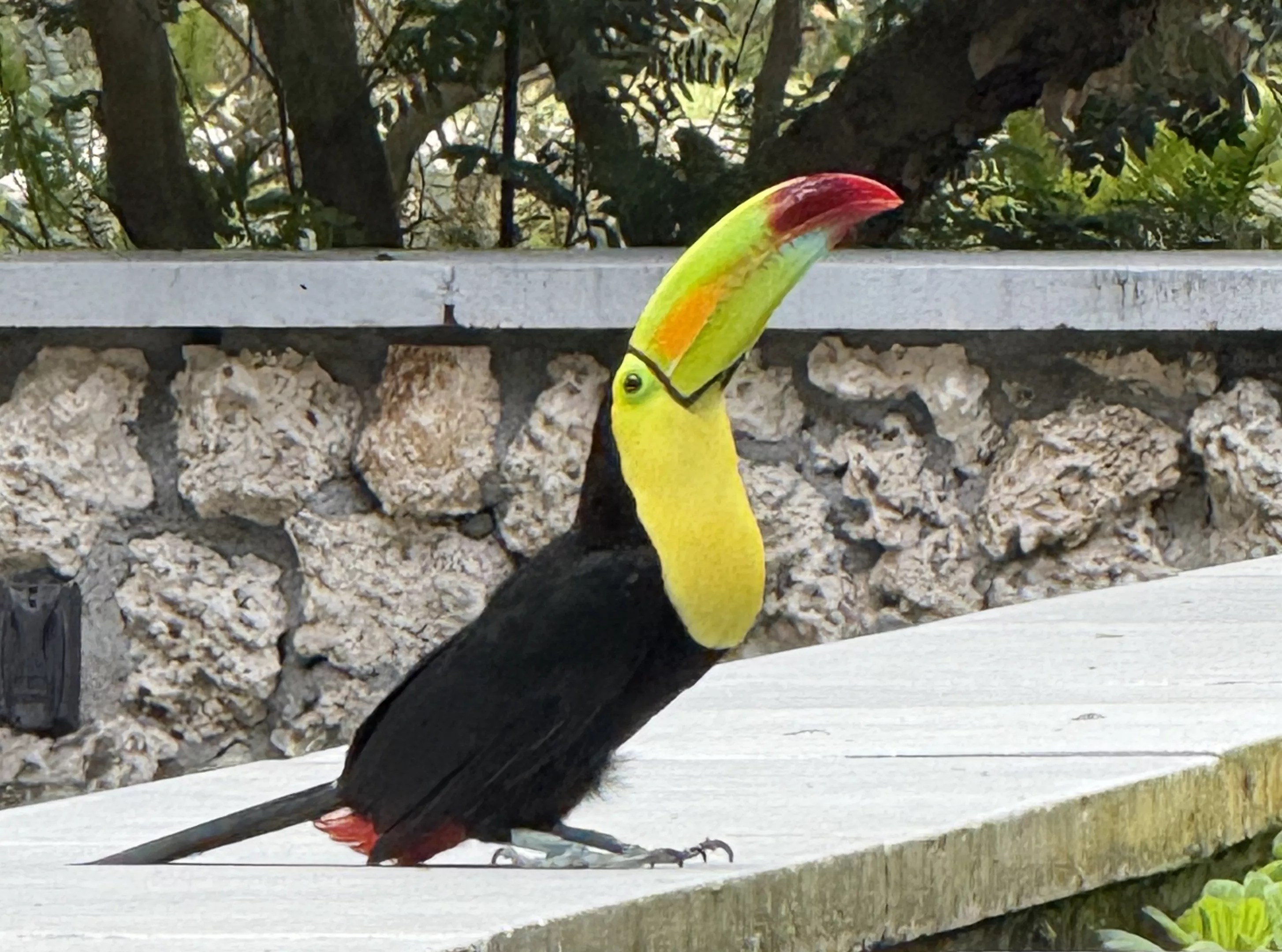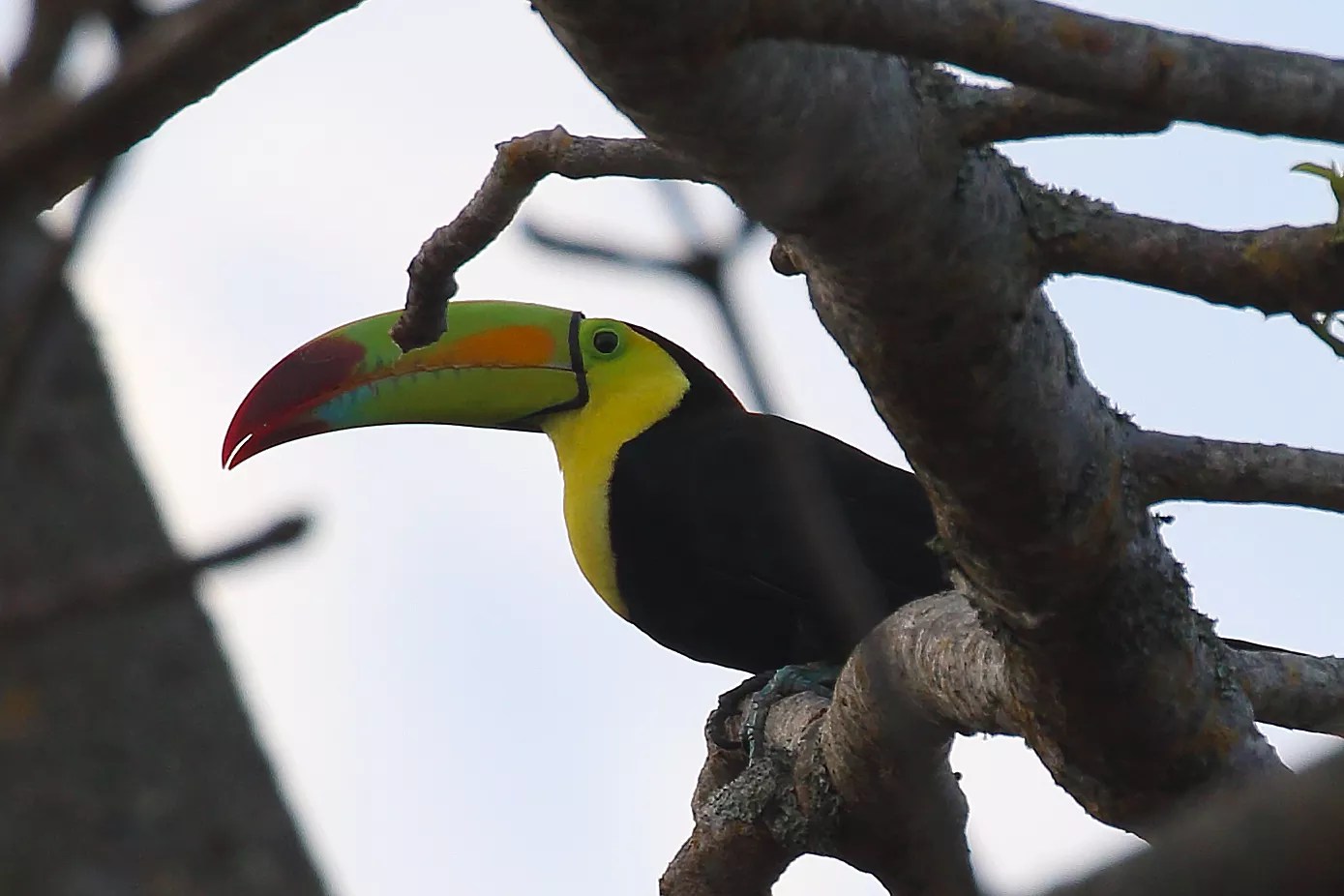
Photo by Jennifer Possley

Audio By Carbonatix
As the field trip coordinator for the Tropical Audubon Society (TAS), Brian Rapoza is used to seeing beautiful exotic birds in beautiful exotic places. But when he spotted a keel-billed toucan this past weekend, with its black-and-yellow plumage and a long, colorful bill, Rapoza wasn’t far from home at all: He was at Fairchild Tropical Botanic Garden.
The toucan was a long way from home, though. This species lives in Caribbean tropical forests from Mexico to Western Venezuela, and Rapoza has seen it in the Yucatán Peninsula. According to eBird, an online database of bird observations used by amateur naturalists and trained scientists, the bird was first reported in Miami on Monday, March 17. Three days later, Fairchild posted on Facebook that the toucan had been spotted on its grounds.
In separate interviews with New Times, Rapoza and Noah Frade, a biologist at Fairchild, agree that the unlikely visitor is probably an escaped pet.
“If you look at a map, the Yucatán Peninsula is not that far from Florida,” says Rapoza, “but it’s very, very unlikely that a bird like a toucan would fly a couple of hundred miles over open water to get here.”
Will you step up to support New Times this year?
At New Times, we’re small and scrappy — and we make the most of every dollar from our supporters. Right now, we’re $18,000 away from reaching our December 31 goal of $30,000. If you’ve ever learned something new, stayed informed, or felt more connected because of New Times, now’s the time to give back.
“They’re not particularly strong flyers,” adds Frade. “They’re not migratory.” He says it’s legal to buy a toucan from a breeder, with costs in the $4,000 range. And, of course, there’s also the black market. “Unfortunately, it’s quite common, especially in Miami.”

This eBird map shows the keel-billed toucan’s usual range in purple, with escapees (including the bird spotted at Fairchild) marked in yellow.
Screenshot via eBird.org
That may explain another recent odd sighting: Last month, a black-casqued hornbill, typically a native of sub-Saharan Africa, was spotted hanging around North Miami. Sightings of the bird have been reported as far south as Biscayne National Park.
Frade says South Florida’s affinity for exotic pets makes these sightings “extremely rare, but certainly not out of the cards,” and Fairchild offers a particularly hospitable environment for the escapee. It’s home to the only tropical rainforest in the continental United States and has a bounty of fruits and lizards for the toucan to feed on.
“I think it’s hanging out at Fairchild because it’s the closest thing to its native habitat [in South Florida],” says Rapoza, “because of all of the non-native trees that Fairchild has planted in their garden.” Frade agrees, adding the garden is “probably one of the best places it could have ended up. It’s an oasis.”
Among Fairchild’s many favorable conditions is its abundance of water sources. Jennifer Possley, director of regional conservation at Fairchild, recorded the toucan as it sipped water from a pool with aquatic plants on Friday, March 28. She was touring the garden with a visiting family during a crowded and busy day, the last weekday of Spring Break. The bird flew right in front of them as they happened upon a quiet area near the Arts Center.
“It was awesome. I screamed when I saw it,” she says. “Seeing it at Fairchild, it kind of seemed like, I don’t know, CGI or something. It was just so big and bold. And even though I knew there was one there, I was still shocked to see it in front of me.”

Photographer Himanshu Gupta snapped a photo of the toucan during a Tropical Audubon Society birdwalk on Saturday, March 29.
Photo by Himanshu Gupta
Fairchild may have lots of water and trees and lizards to munch on, but there’s one important thing it doesn’t have: other toucans. Frade says that isn’t just a problem because toucans are social creatures but also because the bird doesn’t have any other lookouts for potential predators. Cooper’s hawks, short-tailed hawks, and broad-winged hawks all hang out at Fairchild, and red-shouldered hawks nest there. “If this was a captive-bred bird that’s never been in the wild, it might not have that instinct to know to stay away from a hawk,” he says.
Rapoza shares his concern. “If that toucan is not careful – when we saw it, it was just perched in a bare tree with no leaves, so we were able to see it very easily. So if we could see it, a hawk can see it.”
Rapoza last saw the toucan on Saturday, March 29, during a fortuitously scheduled TAS Society birdwalk at Fairchild. About 50 people joined the walk led by Dr. José Francisco Barros, president of the nonprofit organization. Many in the group spotted the toucan and even took photos. It was one of more than 40 species spotted by the group that day. The toucan has not been seen since, but Rapoza reassures, “That doesn’t mean that the bird is gone.” In fact, several days elapsed between the last day it was reported before TAS’ Saturday walk.
“The bird has a lot of places to hide,” he says. “If you’re not familiar with the vocalization it makes – it kind of sounds like a frog, kind of a croaking sound – you would pass it off as maybe a frog or something like that. So it may still be there, but it’s probably just been overlooked since then.”